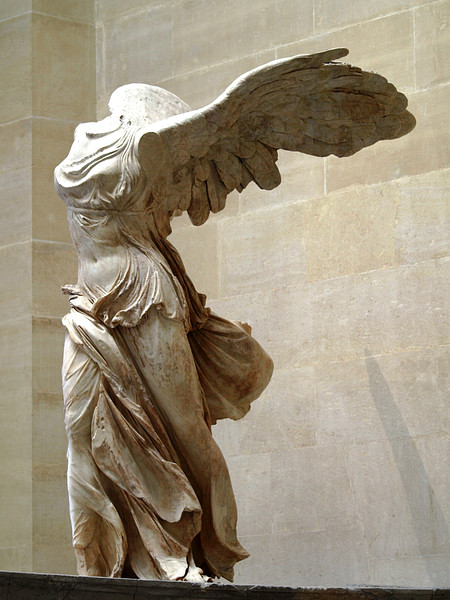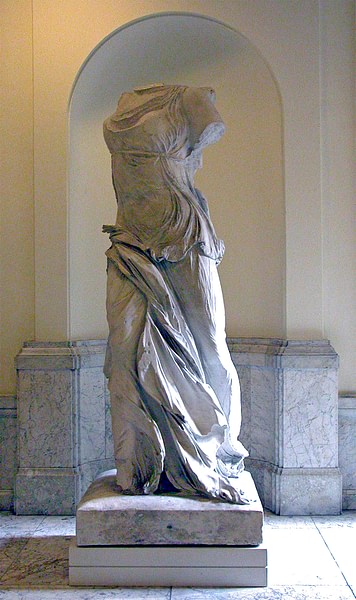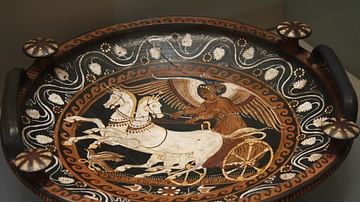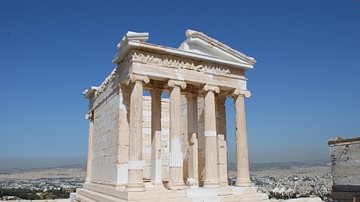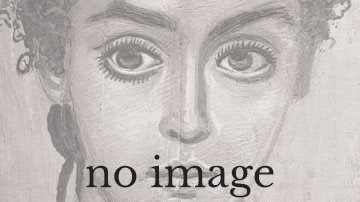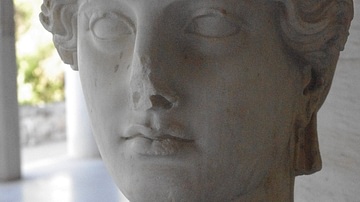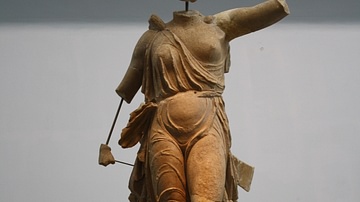One of the most celebrated works of Hellenistic art is without doubt the Nike of Samothrace, on display at the Louvre since 1884 CE. The white Parian marble statue represents the personification of winged victory. In a sense, the impact of the 2.75 m high statue is even greater now because the head and both arms of the goddess are missing.
The masterly rendering of the wavy drapes of her pleated chitōn (tunic) leaves the impression the Nike descends from the heavens in mid-storm. The fabric of her chitōn is pressed against her body as if wet with humid air, yet at the same time, some drapery sways in rolling folds behind her. The goddess wears a girdle under her breasts as well as around the hips, over which pleats fold dramatically. This style of double-girding a woman's tunic was popular in the 4th century BCE. Over her tunic, she wears a himation (mantle), which covers her right leg and is blown against her body by the imaginary force of the sea wind. The feathered wings of the goddess are spread as if in full flight.
The statue was primarily meant to be viewed from its left side in three-quarter view. This can clearly be seen on the right side of the body, which – like the back of the image – is rendered in much less detail. Compared to the dynamic composition and fine details of the left, the arrangement of the statue's right side is rather straightforward. The goddess descends from the heavens and just alights the prow of a ship with her right foot while her left is still in the air. The base of grey Lartos marble suggests that the artwork was not only intended as a tribute to Nike but also served to commemorate a victory in a naval battle. Together with the base and the pedestal on which it stands, the work measures an impressive 5.57 meters in height.
The Island of the Great Gods
The statue of the goddess of victory was excavated in 1863 CE on the Greek island of Samothrace by the French vice-consul and amateur archaeologist Charles Champoiseau. This island was home of the ancient sanctuary dedicated to the Great Gods (Megaloi Theoi in Greek). These enigmatic deities received a Panhellenic chthonic mystery cult, on par in status with the Eleusinian Mysteries of Demeter and Persephone in Attica.
As initiates to mystery cults were sworn to secrecy; little is known about the Samothracian cult and the Great Gods. Due to its strategic location along various trade routes in the northern Aegean Sea, the cult was associated with protection at sea and was therefore popular with seafarers. It is said that the parents of Alexander the Great, Philip II of Macedon and Olympias of Epirus, first met each other as initiates in Samothrace (Plut. Alex. 2.1).
During the Hellenistic period, the sanctuary of the Great Gods underwent intensive renovations when the successors of Alexander the Great (356-323 BCE) tried to surpass each other in generosity and were committed to beautifying and enlarging the temple complex. A monumental entrance was built to the east, the top of the hill to the west was flattened into a terrace, and a colonnade was erected. At the southernmost point of the plateau, on the highest and most remote part of the sanctuary, the statue of Nike was placed in a hewn-rock niche. The archaeological remains of a foundation and the good condition of the marble statue suggest that the Nike was housed in a small building with a roof.
The statue of Nike was, however, found in pieces between the ruins of the sanctuary. Fragments of her clothing and feathers from the wings were also discovered, but the head and the arms were never retrieved. When Champoiseau unearthed a number of grey marble blocks and the remains of a building near the statue, he drew the conclusion that they were part of a tomb.
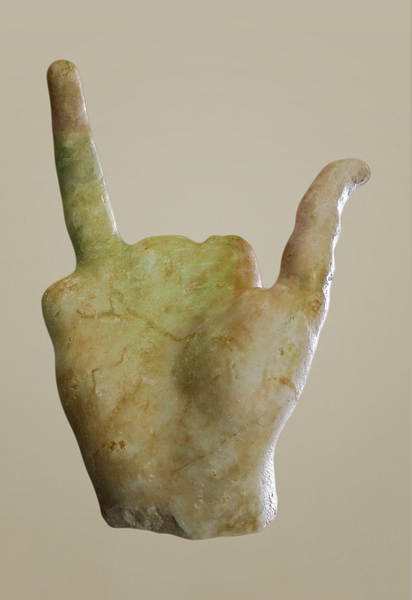
In 1875 CE the site was examined by a group of Austrian archaeologists who realised that the blocks would form the prow of a ship when they were joined together and that the whole had to represent the base of a statue. Champoiseau heard this and had the blocks brought to the Louvre to merge them with the Nike.
In 1950 CE, the fingerless right hand of the statue was uncovered under a large rock near the site where the Nike originally stood. Not long afterwards it became clear that a few fingers, which were stored in the Kunsthistorisches Museum in Vienna, belonged to the statue.
Reconstructions & Hypotheses
Over the years many reconstructions have been attempted of the famous Nike of Samothrace. Not only the head and arms of the goddess are missing but also the feet, while the right wing is a mirror image cast in plaster from the left wing. As such, the present state of the statue still leaves much to the imagination. For instance, did Nike hold objects in her hands? It has been suggested that she may have held a wreath to honour the victor of a naval battle, a trumpet to signal the victory, or that she cupped her hand to announce the victor.
Fragments of the missing parts offer insight into the original posture of the statue. The right wing would have been raised higher and lifted upwards. The right arm would have been held away from the body, with the elbow bent. The fragments of the right hand clearly show that she cannot have held any object as the palm is open and the fingers stretched out. The Nike must, therefore, have simply raised her right arm in greeting. Her left arm may have been held along the body. Her head, so important for such a divine image, may have looked straight ahead, but one can only speculate about the features and expression of her face.
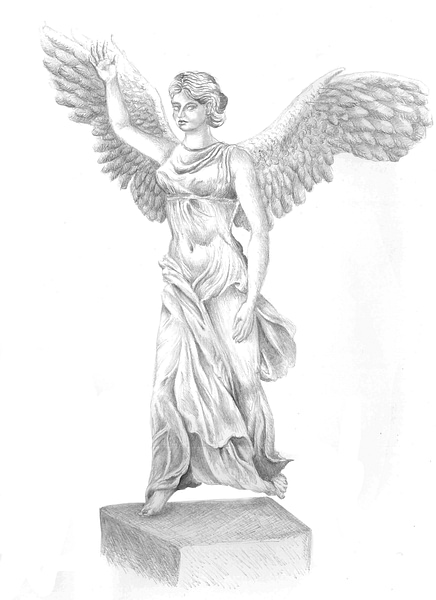
What occasioned the dedication of this masterwork on Samothrace, specifically which naval victory, still eludes us. Hypotheses have ranged the gamut of historically consequential naval victories from the Battle of Salamis (306 BCE) to the Battle of Actium (31 BCE).
From the origin of the grey Lartos marble, quarried on Rhodes for local manufacture, we can deduce that the Rhodians dedicated a victory monument to mark their contribution to the defeat of the Seleucid king Antiochus the Great in 188 BCE. This was also the first time that the Roman Republic engaged in warfare along the Eastern Mediterranean. Samothrace, however, remained under Macedonian control for another two decades.
The aforementioned Battle of Salamis, in which Demetrius I of Macedon (also known as Demetrius Poliorcetes) crushed the naval power of Ptolemy I Soter off the coast of Cyprus, is a problematic candidate. Namely, the ship on which Nike aligns is a so-called trihēmiolia (a type of trireme) that first appeared among the Rhodian fleet during Demetrius' failure to besiege Rhodes (305-304 BC).
Demetrius is unlikely to have had access to Lartos marble and would not have depicted a ship invented by his opponents. Samothrace at the time fell under the suzerainty of his rival Cassander. Demetrius claimed Macedonian kingship only a decade later (294 BC). The victory monument at Samothrace can therefore be attributed to one of the many naval battles before the Treaty of Apamea, probably since the accession of Philip V of Macedon (221 BC).
Conclusion
What makes the Nike of Samothrace so significant is that it is one of the few surviving examples of original Hellenistic sculpture, rather than a Roman copy. Despite its incomplete survival, in mastery, it rivals the pediments of the Athenian Parthenon and the Great Altar of Pergamon. Even if the historical events that occasioned its dedication remain unclear, the Winged Victory is truly a masterpiece of Hellenistic sculpture. It is certain that the winged goddess will continue to captivate viewers, just as she undoubtedly did when she was located in the mysterious sanctuary of the Great Gods.
A version of this article was originally published at AncientWorldMagazine.com.
